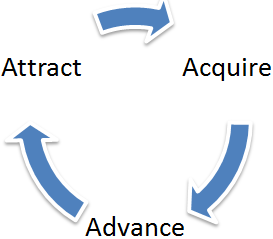Challenging Work as a Driver of Employee Engagement
April 3, 2025
 Challenging Work as a Driver of Employee Engagement
Challenging Work as a Driver of Employee Engagement
Introduction We often hear the term employee engagement being spoken about in various contexts. We are often told by management experts that engaged employees are a source of sustainable competitive advantage. During earlier periods of organizational theory and practice, it was common for the HR (Human Resources) function to take care of administrative aspects such…
 Characteristics of Engaged Workforce
Characteristics of Engaged Workforce
The level of employee engagement can be measured by the willingness and ability of employees to contribute to the success of their organisation. It is their discretionary effort which is an essential element for the good health and well being of a company. A highly engaged workforce shows the high level of engagement in their…
 Benefits of Employee Engagement
Benefits of Employee Engagement
History records how Alexander was able to march on and conquer hitherto unknown lands due his valour and his motivated troops. However, the same history also records, how dissent amongst his troops towards the latter part of his career, cut short his ambitions of supremacy in Asia. Alexander started hiring more outsiders, laying off his…
Employee engagement is a concept that has begun to grab the attention of the corporate world for past few years. When put simply higher levels of employee engagement mean higher profitability of the organisation.
Employee engagement is critical. Highly productive organisations have understood this fact a long ago where mediocre and low performing organisations have just started taking it seriously. It makes sense to engage employees and make them find a meaning in what they do.
Those employees who do not understand what they contribute towards the success of their organisation will not stick to it for long. They would rather consider leaving in a few months or years as and when they are offered a high-paying job.
Employee engagement is a long term process and goes through various phases describing the level of the engagement, involvement, attachment and belongingness between employee and employer. These phases of employee engagement make a continuous cycle that each organisation aiming to achieve increased profitability must undertake.

The first phase of the employee engagement cycle is attracting the best talent from the industry. This phase involves creating a positive impression about the work culture and employee career as a potential employer. It is all about carefully creating an authentic, genuine and crafted image as an employer. This is although an indirect yet the first impression that attracts a big pool of candidates to apply for the job vacancies in an organisation. The first phase is the most important phase of the employee engagement cycle.
Another aspect spreading the reputation of an organisation is its employees. They are not only the employees but also are regarded as internal customers. Their job and career satisfaction speaks about their workplace. Therefore, they should not be taken for granted. Besides attracting the talent from the outside, it is important to keep the existing employees attracted towards the organisation.
The acquire image involves more than one thing. It includes (1) the way the potential candidates are interacted while advertising a position; (2) keeping the promises that were made while hiring them and (3) providing the new joiners a right kind of work culture.
When an organisation advertises a position, interested candidates apply. The way their applications are created, the reaction of the organisation and the manner in which they are approached speak a lot about the image and work culture of an organisation.
Hiring the best talent not only serves the purpose. During their honeymoon or initial period with the organisation, the company must try to keep all the promises that were made during the selection process.
Besides this, they should feel happy and satisfied when their expectations are tested against the reality. Providing the right kind of culture also plays an important role in keeping them engaged.
The whole idea is to prepare them to perform their best by giving them challenging tasks right from the beginning. It’s like developing a habit or culture right from the time they decide to work with the organisation.
Continuous moving the talent is the last but an unending phase. It not only involves promoting the employees to a higher designation along with salary increments but also growing them in other tangible and intangible ways. Job rotation can help them grow in experience, responsibility and belongingness but only when it is done right. Advancing the employees in every aspect, be it monetary or non-monetary, is the key to retain people and develop their overall personality.
These above are the main phases of an employee engagement cycle where preparation is done much before an employee joins the organisation. As mentioned earlier, it is not only about attracting, acquiring and retaining the best talent but also deals in advancing their experience and personality.
Your email address will not be published. Required fields are marked *